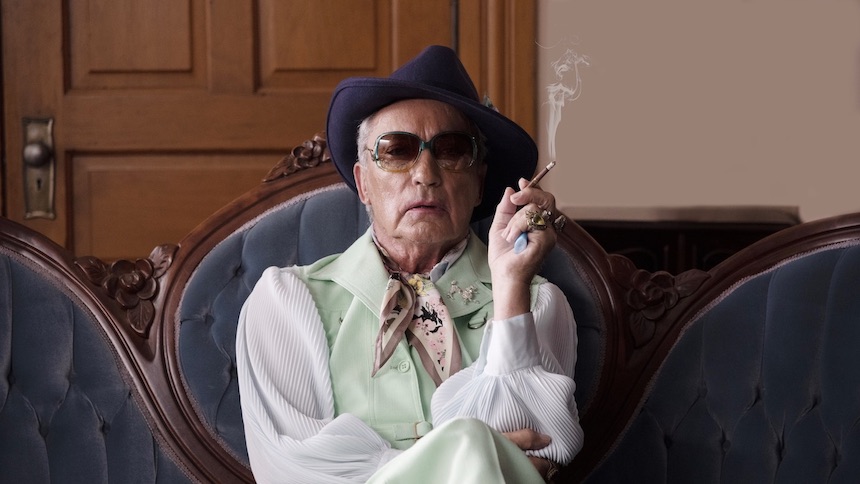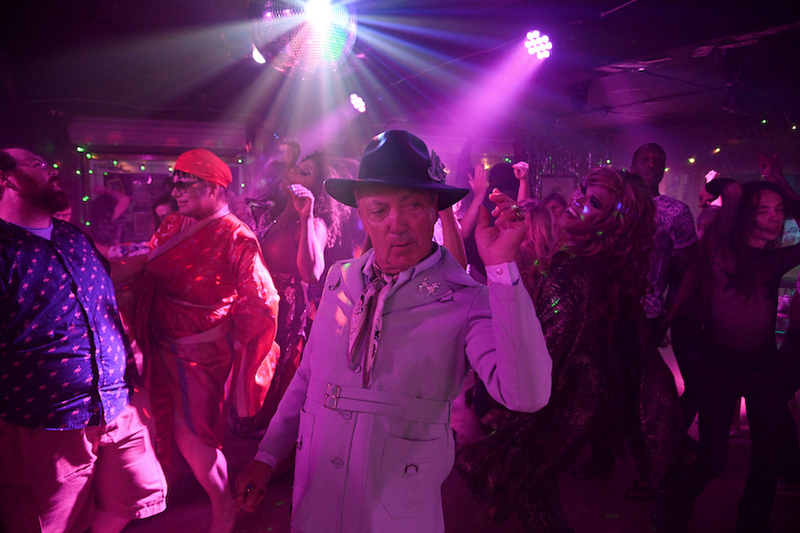SXSW 2021 Interview: SWAN SONG Star Udo Kier and Director Todd Stephens on Their Melancholic, Joyful Gem

In Swan Song, the first feature film in 13 years by Todd Stephens, German actor Udo Kier builds an essential character within a prolific and legendary filmography: more than 250 credits and collaborations with such greats as Paul Morrissey, Rainer Werner Fassbinder, John Carpenter, Dario Argento, Wim Wenders, Lars von Trier, and Gus Van Sant.
Kier plays Mr. Pat, a former hairdresser who now resides in a nursing home, where he entertains himself by folding napkins and sneaking More cigarettes. Pat had a clientele of socialites many years ago in Sandusky, Ohio. Swan Song is the final installment of a "trilogy" set in Stephens' hometown.
The "Ohio trilogy" began with Edge of Seventeen, written and produced by Stephens, and directed by David Moreton. It’s a coming-of-age story that takes place in 1984; the protagonist, Eric (Chris Stafford), is a teenager who, while doing a summer job, is attracted to an openly gay workmate. Eric dreams of going to New York to study music; little by little, his sexual orientation becomes evident: he changes his hair, clothes, puts on makeup, and at one point dances uninhibited at a party. These changes cause him to face various conflicts, rejection and confusion. He breaks a girl's heart, realizes that his gay romance is unrequited (plus, he discovers casual sex), and his mother doesn't know exactly how to react. Edge of Seventeen is a film about accepting yourself no matter what.
Stephens made his directorial debut with Gypsy 83, another coming-of-age starring a couple of friends who live in Sandusky and are viewed as the “weird misfits.” Gypsy (Sara Rue) is a young woman who idolizes Stevie Nicks and dreams of succeeding as a singer, something that is painfully linked to her mother: she abandoned her when she was little to pursue her musical dream. Gypsy's best friend, Clive (Birkett Turton), has a Robert Smith-like goth look (it’s no coincidence that there’s music by The Cure) and throughout the film struggles to accept his sexual preference. Developed as a road movie – the friends head to New York for a Nicks tribute show – Gypsy 83 stands for moving forward to follow your dreams, despite the rejecting environment or your own fears.
Todd Stephens closed his "Ohio trilogy" 20 years later, portraying a real-life character who was fundamental for the filmmaker during his formative years in Sandusky. The protagonist of Swan Song was “a real role model for me growing up,” revealed Stephens in an interview with ScreenAnarchy, and added that: “I never felt like I fit into my hometown. It’s changed a lot over the years but it was a very conservative place back in the day.
"Pat was the opposite of that: he just was this bright, shining peacock. He gave me the courage to know that it was OK to be different. I always wanted to make a film about him and pay him homage, I actually wrote a Mr. Pat character in my first film, Edge of Seventeen, that wound up getting cut. Part of the problem is that we couldn’t find the right person to play him, it takes a very special actor to pull that character off. That was 20 years ago, all of this time I always knew that when the time was right, I was going to make my Mr. Pat film.”
Here enters the great Udo Kier, capable of delivering multilayered performances. About this role, Kier commented: “After having made The Painted Bird, I got the script from Todd for Swan Song, I read it and liked it. After playing always the evil gangster and vampire, I didn’t just want to play this role with no aggression or idea of destroying, I wanted to become Pat. I went to Sandusky, I walked a lot around the town on my own, I went to places, to bars where the real Pat used to go. I talked to friends, they told me how he behaved and all these little movements. Pat was a kind of a legend in this little town because he was different, nobody was aggressive to him.”
In the beginning of Swan Song, Mr. Pat receives news of the death of Rita Parker-Sloan (Linda Evans), who was his best client and friend. The lady stated in her will that she wanted Pat to be the stylist for her funeral in exchange for $25,000 dollars. Although Pat initially declines the juicy offer, he soon returns to Sandusky with almost no money, notorious health problems and lots of attitude.
As Mr. Pat comes back to the places in Sandusky that marked him, he faces memories and the inevitable passage of time reflected in the town’s drastic changes. Certain wounds remain open. “I just didn’t want to have being gay as the conflict in the story. There’s been a lot of films that dealt with gay subject matter where that has being a conflict, including films that I have made. But I wanted to go beyond that and deal more with aging and having outlived all your friends and your partner,” Stephens asserted.
This reveals the tragic past of Pat, who lost everything. His former protege Dee Dee Dale (Jennifer Coolidge) set up her own salon and succeeded. His partner David (Eric Eisenbrey) died of HIV. His friend and client Rita didn’t even attend the funeral; we understand that this relationship was always conditioned by external appearance in a more difficult time for the LGBT community. Swan Song, like the other films in the "Ohio trilogy," is intimate, character-driven cinema that reaches a different level of social relevance.
Stephens recalled that in his small town, “AIDS really hit hard, really decimated the community including many of Pat’s friends. There’s this whole almost lost generation of the community. There’s a history there that I hope people don’t forget. I hope that the younger generation doesn’t forget what the older generation went through to help pave the way.” The film is dedicated to the memory of the victims of the HIV pandemic.
Swan Song is nostalgic and melancholic, also joyful and inspiring. Pat doesn’t miss the opportunity to do again what he always loved: dress fashionably, go to the local gay bar, dance, step onto the stage and, of course, follow his unique hairdressing ritual to the letter.
Likewise, it’s time for the protagonist to heal wounds, to know the lives that he changed and his everlasting legacy. According to Stephens, “Pat to me was like an artist with his hands, so it was also about how you have this thing that you love and then you lose it. It was about rediscovering that, Pat rediscovering life again after having been given up on life.”
As genre cinema aficionados, we have encountered Udo Kier frequently in recent years. He had supporting roles in productions such as The Editor, Brawl in Cell Block 99 and Puppet Master: The Littlest Reich. In Iron Sky: The Coming Race he played two characters, giving us that insane moment with Adolf Hitler riding a T-Rex on the dark side of the Moon.
It's especially refreshing and wonderful to see Kier in Swan Song, enjoying to the full being the center of attention once again. Kier emphasized that “this is the first time in a long time where it’s all about me and that’s a difference. When I’m in Ace Ventura: Pet Detective or Armageddon, I have one or two scenes. But now, since Flesh for Frankenstein and Blood for Dracula where I was the leading man, it’s the first film where I have the absolute lead. That’s so important for me.”
"I was not acting, I didn’t want to imitate Pat, I just became Pat, this man who was happy that he got all of the sudden a green suit as a gift and he becomes really alive again. People laugh or cry because it’s about a real person. A few very good friends have seen the film and they said: ‘Udo, we’ve never seen you like that.’ Todd shouldn’t hear it: Swan Song is the most important film in my career,” the legendary actor emphatically concluded.
A version in Spanish of this interview was also published at Cinema Inferno









